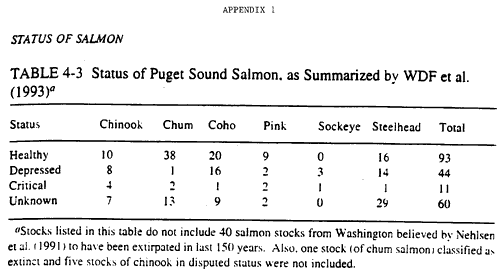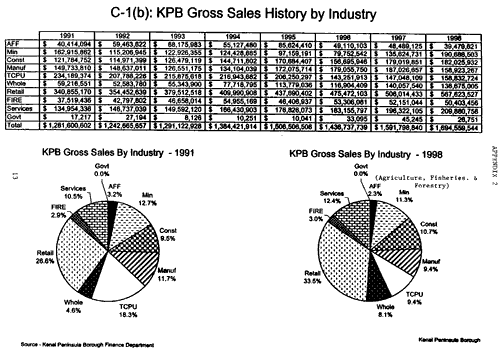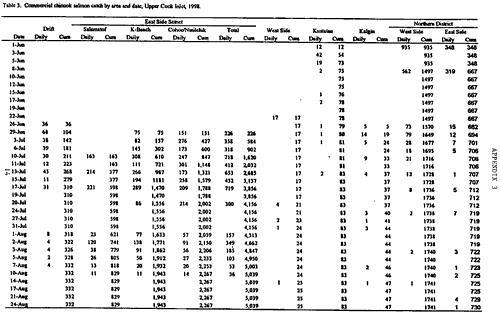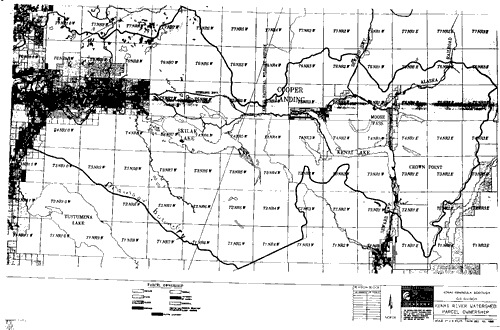
This paper was written as part of the 2000 Alaska Ocean Sciences Bowl high school competition. The conclusions in this report are solely those of the student authors.
Kenai River Fisheries Management
Skyview High School
Salmon have great cultural, economic, recreational, and symbolic importance to Alaskans. Survival of the salmon stocks depend upon a diverse store of genetic variation of wild salmon. Efforts in the Northwest have been somewhat ineffective due in part to not addressing the problems in a timely manner. Now is the time for Alaskans to take action and manage their salmon resources to ensure a supportable yield. Those salmon resources support three main types of fishing activities that include commercial, sport and subsistence. Commercial fishing is defined here as the catching of fish in mass by nets and used for resale. Sport fishing is catching fish individually by rod and reel. Subsistence fisheries are for people who depend upon the fish for a major part of their diet(Kenaitze subsistence article). Commercial fishing in 1998 contributed less than 2.3% of the gross sales on the Kenai Peninsula or about $39.5 million. This figure is a little misleading because it includes the contribution of forestry industries, although it is much less than the fishing industries portion (appendix #2). There are two types of commercial fishing in Cook Inlet and they both use gill nets; set netting and drift netting. The set net fishery takes place all along the Cook Inlet shores. Each set net can extend out thirty seven fathoms in length. A set net site must have 600 feet between nets, but can extend their nets anywhere from one half mile to a mile depending upon location. The drift fishery takes place out in Cook Inlet but is restricted to an area that extends from one and a half miles from the east side shore to three miles out and between Anchor Point to a line even with the North Forelands. The boats can extend a gill net one hundred fifty fathoms behind and have the advantage of being able to travel to the schools of fish. Both of these fisheries are regulated with closures/openings set by the Department of Fish and Game according to escapement numbers which is a count of those fish that are making it into the river. Since these fisheries use nets, they are not selective in the species of salmon that are caught(Upper Cook Inlet Commercial Fisheries Annual Management Report,1995). This contributes to the confrontation between the sport and commercial fishermen. chinook salmon are the main species sought after by many tourists and guide boats in the sport fishery, but many of the chinooks are caught in the nets in the Inlet even though they are not being targeted (appendix #3). The sport fisheries are predominantly either king "chinooks" or red "sockeye" salmon. The kings of the Kenai River are world class and attract many tourists. Boats are usually used since these fish are generally found in the deeper waters. The number of guides was two hundred seven in 1982 and has increased to four hundred sixty three in 1999. If the number of private boats is included, there may be up to three hundred boats per day on the river. Since 1986 some restrictions have been in effect . One restriction limits the boat motors to thirty-five horse power to help reduce the boat wake damage on the river banks. There are some sections of the river that motors are not allowed. In years when the runs are small, the Alaska Department of Fish and Game will restrict fishing to catch and release. This is to help keep the escapement numbers as high as possible. Even though research does not indicate that this catch and release causes problems with spawning, it can not be ruled out. Red salmon fishing also create a big impact on the Kenai River environment. Thousands of tourists come to the Kenai River banks to catch them. The reds keep close to the banks as they head for the spawning beds and with all of these people lining the banks, the stream side vegetation gets trampled and erosion increases. This can ruin prime salmon rearing habitat. This is a problem all along the river but is extreme at the mouth of the Russian River where hundreds of fishermen line the bank day and night during the run. Though these tourists put pressure on the river's habitats, they also bring substantial benefit to our economy(Nelson et al, 1999). In 1996, the economic value expended by all anglers was estimated to be over forty three million dollars. Subsistence is a third type of fishery. It is defined as a means of acquiring the necessities, food and shelter, of life. To natives such as the Kenaitze, however, it means much more. Other than being a source of food, the fish may also be used to feed their dogs which are of traditional importance. Salmon obtained through the subsistence fishery is also a major part of the Kenatze's cultural needs where historically a person's wealth was shown by how much they shared or gave away. Subsistence is a way of caring for other members and promoting family and tribal unity. An analogy was made by Kenaitze member, Rita Smaggy: "Like any wild creature that needs to migrate and find their way around obstacles, the natives must find a way to preserve their lifestyle". The natives have the same concerns that many of the local non-natives express regarding the health of the salmon resources. They have worries about the survival of the fish stocks and believe that there is a need for human stewardship. Since salmon spend their lives in two different ecosystems, they are susceptible to problems in both. While the salmon live in the fresh water, they develop through a series of stages which include the eyed egg, alevin, and fry. Each stage has different habitat needs. The eyed egg and alevin stages stay in the spawning habitat which is under the rocks of a riffle area. This is generally in the middle of the river and where the currents are fastest. In the spring, they become fry and move to the sides of the river to what is called the rearing habitat. This habitat is important because it helps the fry hide from predators and if they are sockeye, to swim upstream to the lakes. This is where their habitats can easily be damaged. The fry need overhanging vegetation to hide from birds and larger fish. The currents by the banks are also slow enough to allow the fry to swim easily against them. When the rivers edge is trampled, the vegetation won't be there to provide the cover. If the vegetation is killed, it will no longer be able to hold the embankment together and it will slough off. This further decreases the cover as well as reducing back eddies and allows the currents to become too fast. In late spring, the salmon leave the river to go to the sea and are called smolt. The portion of their lives spent in the ocean remains somewhat of a mystery. It is not fully understood where they go. They may migrate in a circle around the Gulf of Alaska as they mature and hunt for food. This pattern may take them beyond the two hundred mile U.S. exclusion zone. But while the salmon are in the ocean, the major environmental factor seems to be the water temperature. The water temperature may fluctuate significantly if the El Niño / La Niña phenomenon is occurring. This temperature fluctuation has a large impact on the bottom of the food web which in turn affects the salmon's food supply. Weather, water temperature, high or low stream flow, ice flows and drought are all important environmental factors that affect the salmon while they are in the streams and lakes. The salmon are very sensitive to temperature changes and the ideal temperature is 55 deg F "Small Sockeye Runs". Floods and ice flows can cause the spawning beds to be washed or gouged out. Drought may cause the water levels to drop and expose the redds to drying out. Even landslides may be detrimental to salmon if the beds become covered and the eggs buried. Humans cause huge impacts on the salmon ecosystems. One of the biggest money makers by far in Alaska is the oil industry. The oil industry can also be one of our biggest environmental hazards. Many small oil spills take place every year. Every once in a while, a big oil spill will occur and affect everyone whom depends on the natural resources along with impacting the ecosystems. The Exxon Valdez oil spill of 1989 was devastating and there still remains oil in hidden crevices and even out in plain sight. This particular spill affected not only the salmon but almost everything that has to do with the Prince William Sound ecosystem. The natives, who depend on about 250-500 lbs of fish a year, were deprived of the right to obtain the needed amount of fish for their winter stocks. About fifty percent of the local fishermen say that the fishing industry just hasn't been the same. The Exxon oil company worked very hard to clean up the mess and gave Alaskans a healthy settlement. It is good that Exxon tried to make up for its mistakes, but the main question now is whether the oil platforms and tankers will continue to accidentally pollute the water and get away with it. Another big pollution factor is, as always, inconsiderate people that are too lazy to dispose of their trash in the appropriate manner. A great deal of trash is found washed up on beaches tangled around animals and many times can be seen floating down the river. Boats also create a fairly large cloud of pollution. The motors deposit hydrocarbons into the water that can pollute the food particles that fish need to stay alive. Along with that, boats carry people who leave cigarette butts, sandwich bags, gum wrappers and all sorts of fishing tackle that often ends up tangled somewhere on a river bank. Bank erosion is another major impact on the salmon streams and there are two general causes. One of them is the foot traffic. The bank anglers have trampled the shores from grassy waterfront to mud. Many are having a fun time without knowing what their boots are doing to the shore. The other major cause of bank erosion is the boat wakes. Above the Bridge Access Road, the boat motors must thirty five horsepower or less. The Bridge Access Road is a road that crosses the Kenai River about four miles from the mouth. This restriction is sometimes not followed real closely but even the thirty five horsepower motor will throw large wakes at the shore when the boats are over loaded. The area surrounding the Kenai River is becoming more urban and problems related to the urban lifestyle are starting to have an effect. Those problems include yards with trimmed lawns down to the waters edge which allows runoff with fertilizers to flow right into the water. More houses also increase the runoff with chemicals such as oil, pesticides, and other toxins. Other people have built rock jetties to form back eddies or concrete embankments to reduce erosion. The problem with jetties and embankments is that the waters current increases which makes it hard for salmon fry to swim upstream to the lakes. Homeowners like to cut down the trees in their yard so they can get a better view of the river. But according to Fish and Game biologists, there should be a one hundred to two hundred foot buffer to filter the runoff. Due to political pressures the current buffer requirement is set at fifty feet. Also, agricultural practices have cleared land immediately adjacent to some of the tributaries, wetlands are being filled in and the natural drainage altered in other areas. Many people believe that they should be able to do what they want with their own property. Urbanization can bring a variety of other problems. One of those problems is sewage. Sewage treatment plant failures have already dumped toxic chlorine into the river. Contaminated land from a dry cleaners has also been discovered on the Kenai River banks. It is very hard for controlling agencies to protect the environment over the wishes of local people and businesses. It is easier, politically, to favor economic growth over conservation. People do not realize or care what harm is possibly being done to the needed habitats of the salmon fry. The best thing we have found to reduce the pressure on the river is zoning but there are few people willing to do this. Zoning is where a section of the river is set aside from development or returned to almost what it was before the river became damaged. This is very expensive though. It has been determined that for every quarter mile that has been destroyed, it will cost $750,000 to fix. Another impact by humans has been hatcheries which have been used in an effort to lessen the effects of man on the salmon populations. The lessons from the Pacific Northwest, however, is that hatchery fish have had an adverse effect on the native salmon populations. They have caused a reduction in the genetic diversity and altered the fishes behavior by rearing them in ideal situations. Hatchery fish can also spread diseases quickly among each other and to the wild stocks. In some cases they have even displaced the remnants of some wild runs. The use of the forests may also affect the salmon habitat. Development of the forests include roads, logging, and mining. All three of these uses increase the runoff of sediments that are no longer held in place by the plant roots. From the roads, the runoff may include the pollution of hydrocarbons from vehicles. The runoff from mining operations often includes chemical toxins that are used in the extraction of metals. Logging is perhaps the biggest concern because the volume of the sediment runoff is the greatest. Logging is often done right up to the streams edge so there is no possible filtering of any sediments out of the water. Protective barriers or strips next to each stream are important, but they must be at least one hundred feet wide. If the barrier is too narrow, the trees can not support each other and often are blown down. This is what happened in Windy Bay on the south side of the Kenai Peninsula. Many of the narrow buffers were blown down and erosion still occurred. Management of the Kenai River drainage ecosystem is a complicated task. There are a variety of issues that need to be addressed, and they include land use as it affects the riparian habitats, wetlands and floodplains; head waters and drainage, development, escapements, special interests, funding, recreation, boat use, enforcement, logging, mining, pollution, and other environmental issues. There are also many entities that have an interest in protecting the Kenai River and its resources. They include:
KPFA- Kenai Peninsula Fishermens' Assoc. The Kenai River drainage has been managed through a series of "plans" over the last twenty years. The Kenai River Comprehensive Management Plan and Kenai Area Plan have been used by the DNR to manage lands under its control. The Chugach National Forest Land and Resource Management Plan and Kenai National Wildlife Refuge Comprehensive Conservation Plans were developed by the USFS and USFWS for their respective areas. The Upper Kenai Cooperative Plan is an attempt by all the above agencies to manage the Upper Kenai River drainage. The Kenai Peninsula Borough has two separate plans in place: The KPB Comprehensive Plan and the KPB Coastal Plan. With all of these agencies, the management of the Kenai River has been fragmented. During 1996 and 1997, the Kenai River Advisory Board (KRAB) has been attempting to revise the Kenai River Comprehensive Management Plan as an attempt to coordinate all the various efforts. It has included representatives from commercial and sport fisheries, property owners, commercial guides, agency personnel from appropriate state and federal entities, and representatives from local city and borough governments, as well an members from the communities at large. This is a good first step. To be effective, all groups with an interest must be involved and the plan must be comprehensive. This means the resources can only be managed effectively if the whole ecosystem is addressed. The priorities of any plan should be 1)watershed protection, 2)habitat protection, and 3)escapement. Watershed protection means keeping a watchful eye on the whole drainage from the head waters to the Kenai's mouth and making sure the water quality does not change. For example, a mining operation close to the Snow River should not have an effect on down stream spawning habitats. Habitat protection is more localized and might involve protecting wetlands, river banks, or making sure there are no obstructions put up to change stream flow. For example, the mouth of the Russian River area gets significant fishing pressure along the banks. The escapement to the river is good, but there is an extreme amount of foot traffic. Some ideas are to close down the river during certain times or days or perhaps shut down the ferry for a while each day to give the banks a rest. The most ideal solution is to construct boardwalks along the banks but the cost is expensive. Hence there is a need for funding such projects. Focus on escapement emphasizes the importance of salmon as a renewable resource. The first two priorities will allow the salmon to flourish once they return to the spawning beds and escapement management allows for effective harvest while protecting future populations. When observing the Kenai River drainage map, one can see how much of the area is already protected (appendix #4). Large portions are set aside in the Chugach National Forest or Kenai National Wildlife Refuge. Only the lands along the river from Skilak Lake to the mouth and a few other isolated pockets are in private ownership. These are the areas where habitat protection will be the most difficult. Money to fund various preventive or restoration projects may come from one of three possible sources. User fees could be charged at parking and camping areas and boat ramps along the river. If the people of the community knew that the funds went directly to the local Kenai River, they would be supportive. A funding format similar to the Kenai River classic could also be used. This has been proven to be quite successful. Celebrities are invited to compete in a fishing derby and people are charged money for the opportunity to fish along with them. Probably, the best source of funds would be corporate underwriting. Many corporations are earmarking a certain amount of money for environmental causes. The BP/ARCO merger is one example. BP has publicly stated that it intends to spend millions of money in California for environmental purposes if its merger is approved. They might also be encouraged to provide money for Alaskan environmental needs. The enforcement of the regulations would still fall on the appropriate governmental agencies, but there must be emphasis on cooperative efforts. The laws and regulations must seem fair and enforceable by the public and consistent with the management of the river and its resources. Protection and enhancement of a whole ecosystem is very difficult but if a way is not found to address these issues, the loss of the salmon resources of the Pacific Northwest will be repeated in the Kenai River.
BibliographyAlaska Dept. of Natural Resources, Division of Land, Division of Parks & Outdoor Recreation, Dept. of Fish & Game Habitat & Restoration Division, Kenai Peninsula Borough; Kenai River Comprehensive Management Plan. Nov. 1998.Alaska Dept. of Transportation and Public Facilities, "Annual Traffic Report". 1995-1998. Camp, Jeanne, "Situations and Prospects of the Kenai Peninsula Borough". 1998. Kenai Peninsula Borough Economic Development District., Inc. "Commercial Fishing Industry." Aug. 1998. Kenaitze Indian Tribe, "Background History Subsistence Fishing". 1996. Kizzia, Tom. "Crumbling the Kenai One Piece at a Time." ADN. Kizzia, Tom. "From Mile 50 to the Mouth, July Ride on the Kenai is a Tour of Stream side Damage, from Subtle to Stark." ADN. National Research Council. Upstream, Salmon and Society in the Pacific Northwest. Washington D.C.:National Academy Press. 1996 Nelson, Dave, David Athens, Patricia Berkhahn, and Sandra Sonniechsen; "Area Management Plan for the Recreational Fisheries of the Kenai Peninsula, 1995-1997. Sept. 1999. "Prince William Sound, an Ecosystem in Transition." NOAA, 12 Oct. 1999. http://www.response. restoration.noaa.gov/spotlight.html. 5 Nov. 1999 Ruesch, Paul H., and Jeff Fox. Upper Cook Inlet Commercial Fisheries Annual Management Report, 1998 Smaggy, Rita. Personal Interview, Skyview High School. 16 Nov. 1999. "Small Sockeye Runs Blamed on Warm Water." ENN Daily News, 17 Aug. 1997. http://www.enn.com/enn-newsarchieve/1997/08/081497/08149713.asp. 20 Oct. 1999. Tripp, Angela, ed. Pacific Salmon, Alaska's Story. Santa Barbara:Albion, 1998. Tarbox, Kenneth E., and Terry Bendock. "Can Alaska Balance Economic Growth with Fish Habitat Protection?, a Biologist's Perspective". Alaska Fish & Game, 1996.
|
AppendixesAppendix 1:
Appendix 2:
Appendix 3:
Appendix 4:
|
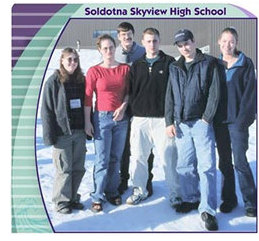 Written in part by each of the following:
Written in part by each of the following: